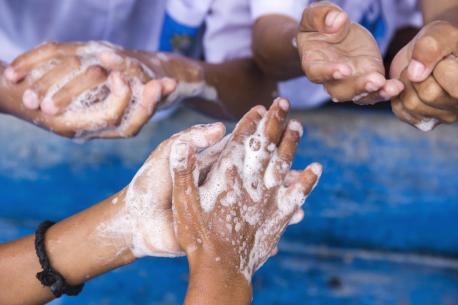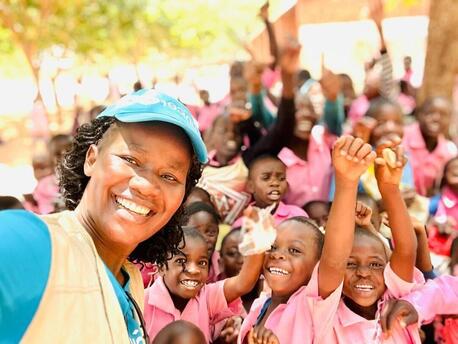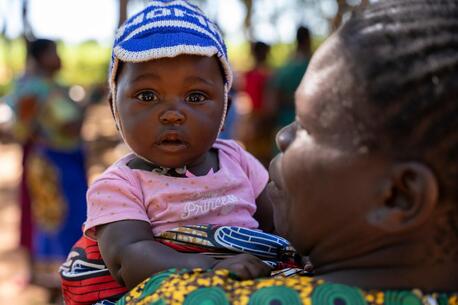
Coronavirus in the U.S.: How to Prepare
Health experts are warning the disease will spread. Here are some simple steps you can take to protect your family.
UPDATED April 27, 2020
Help UNICEF be there for vulnerable children around the world during the coronavirus global health emergency. Your support is urgently needed.
With one-third of the world's population living under coronavirus restrictions, each day brings more unsettling news of the global pandemic. Countries worldwide are in lockdown mode, with 191 closing schools nationwide, affecting more than 1.5 billion children and youth. According to official accounts, the coronavirus pandemic has sickened over 2.9 million people.
On April 24, heads of state and global health leaders announced they were working together to accelerate the development and production of new vaccines, tests and treatments for the new coronavirus.
“We will only halt COVID-19 through solidarity,” said Dr Tedros Adhanom Ghebreyesus, WHO Director-General at the video conference held to launch the pact. “Countries, health partners, manufacturers and the private sector must act together and ensure that the fruits of science and research can benefit everybody.”
Without innovative COVID-19 vaccines, diagnostics and treatments, the entire world remains at risk. At a briefing just two days before, Tedros warned world leaders to be prepared to manage the pandemic for some time to come. Over the last few weeks, countries have seen cases rise, fall and begin surging again in areas where the coronavirus seemed to be under control.
“Make no mistake, we have a long way to go. This virus will be with us for a long time,” Tedros told the press at WHO headquarters in Geneva.
Despite the daily reports of new cases, families can protect themselves by following these measures: Stay at home, wash hands frequently, practice physical distancing and look to trusted sources like WHO and the CDC for the latest news on how to stay safe.
How to protect yourself and your family from coronavirus
- Wash hands often and well. Use soap and water or an alcohol-based hand sanitizer.
- Avoid touching your face with unwashed hands.
- Cough or sneeze into the inside of your elbow.
- Keep your distance from anyone who has cold or flu-like symptoms.
- Contact your health care provider if you have a fever, cough or difficulty breathing.
What is coronavirus?
According to the WHO, coronaviruses (CoV) are a large family of viruses that cause illnesses ranging from colds to more severe diseases such as Middle East Respiratory Syndrome (MERS-CoV) and Severe Acute Respiratory Syndrome (SARS-CoV). A novel coronavirus (nCoV) is a new strain that has not been previously identified in humans. The new (novel) coronavirus sparking panic around the world today was first detected in Wuhan City, in China's Hubei Province. Though commonly known today as coronavirus, its official name is “SARS-CoV-2” and the disease it causes is called “coronavirus disease 2019” or “COVID-19” for short.
What is a pandemic?
According to the WHO, a pandemic is a disease that spreads worldwide. With the number of confirmed cases of COVID-19 approaching 2 million, and at least 122,000 reported deaths, staying calm may take concerted effort.
The last time a pandemic occurred was in 2009, when the H1N1 flu pandemic killed an estimated 151,700 to 575,400 people globally in one year.
In declaring the outbreak a pandemic on March 11, Dr. Tedros said, “All countries can still change the course of this pandemic....We're in this together, to do the right things with calm and protect the citizens of the world.”
How can you do your part? Seek out the advice of experts and fight misinformation, and if possible, donate online to UNICEF to help protect vulnerable children. Here, to set the record straight, is advice from the WHO and other trusted sources about how to keep everyone safe.
How does the coronavirus spread?
You can catch the coronavirus if you are within six feet of an infected person when they sneeze or cough and their respiratory droplets end up in your mouth, nose or eyes.
Symptoms that may appear 2 to 14 days after exposure to the virus may include fever, cough or difficulty breathing, chills, muscle pain, headache, sore throat and/or a sudden loss of taste or smell. Stay home except to get medical care. When coughing or sneezing, stay at least six feet away from others to keep them safe. If you begin to experience persistent pain or pressure in your chest, sudden onset of confusion and your face or lips take on a bluish cast, call your health care professional.
Proper respiratory hygiene — coughing or sneezing into your elbow or a tissue — and frequent, thorough handwashing can help keep everyone safe. Also reassuring is that the coronavirus is not airborne. There may be some confusion on this score, because health care workers are urged to take special "airborne" precautions when performing specific procedures on patients who are very ill, particularly those who are intubated.
Should I wear a mask if I'm not sick?
Guidance from WHO and the CDC differs somewhat on this point.
The WHO's position is this: "Only wear a mask if you are ill with COVID-19 symptoms (especially coughing) or looking after someone who may have COVID-19. Disposable face mask can only be used once. If you are not ill or looking after someone who is ill then you are wasting a mask. There is a world-wide shortage of masks, so WHO urges people to use masks wisely."
The CDC says: "In light of new data about how COVID-19 spreads, along with evidence of widespread COVID-19 illness in communities across the country, CDC recommends that people wear a cloth face covering to cover their nose and mouth in the community setting. This is to protect people around you if you are infected but do not have symptoms."
The CDC took this position in light of new studies that show that significant numbers of people who are infected with coronavirus do not exhibit any symptoms. People who are pre-symptomatic can also transmit the virus to others. So in line with the WHO, which recommends that all people who are sick wear masks, the CDC's believes that the safest course is for everyone to presume they are infected and wear a mask to protect others and help stop the spread of the virus.
Two important caveats: People should not be trying to procure or wear N-95 masks. The nurses and doctors treating the sick and saving lives need those to protect themselves. And even if you are wearing a mask, it is still imperative to stand 6 feet away from others.

Despite popular belief, masks should only be worn by people who have coronavirus or those who are treating the sick. Above, women and children line up outside a hospital in Phnom Penh, Cambodia. © UNICEF/UNI288092/Chhin Sothy/AFP-Services
How long does the coronavirus last?
Fourteen days is considered the upper end of the incubation period. But most people will show symptoms five or six days after being infected. People who develop coronavirus will be sick for a matter of weeks.
Up to 80 percent of the people who are infected by the coronavirus will develop a mild case. The 20 percent who contract a severe case of the disease will require hospitalization and advanced care. Particularly vulnerable are those with underlying medical conditions such as cardiovascular disease, diabetes and chronic respiratory disease. But so far, many have gone on to recover when treated in a properly equipped health care facility.
Coronavirus vaccine progress
While the CDC has developed a test to diagnose COVID-19, there is no vaccine yet. However, there are more than 100 potential COVID-19 vaccines in development. Since January, researchers from hundreds of institutions have been working with the WHO to develop and test vaccines, standardize potency requirements and regulatory approaches for trials and decide which possible vaccine candidates to prioritize. The WHO tests are being used all over the world, and more are in the pipeline. The WHO is also coordinating a global trial to assess the safety and efficacy of four therapeutics against COVID-19.
The challenge is to speed up and standardize processes so that safe and effective products once available can quickly get to the billions of people in the world who need them.
“As new diagnostics, treatments and vaccines become available, we have a responsibility to get them out equitably with the understanding that all lives have equal value,” said Melinda Gates, co-chair of the Gates Foundation, said at the April 24 launch of the collaboration to speed COVID drugsalong with a host of other world leaders.
Preparedness plan
Planning for the coronavirus isn't any different from preparations you might make to keep your family safe during other types of emergencies. As families who are sheltering in place know, having a first aid kit — including a working thermometer — a well-stocked pantry and several reliable grocery delivery options makes daily life easier. But the suspension of life as we knew it can make coping tough.
More than 1.5 billion learners around the world have been affected by school closures to date. With schools closed across the U.S. requiring children to learn remotely, parents and children must find new ways to work and learn together during a time of extreme anxiety.
When talking to children about coronavirus, listen to their concerns and give them enough information to relieve their stress. If you don't know the answer to their question, look it up together using trusted sources like the WHO and UNICEF, and offer reassurance.
According to our interview with Dr. Ronald Kleinman, Physician-in-Chief, Massachusetts General Hospital for Children, "It’s important to remember that, for the most part, children have a milder illness. And, just as it is with adults, those children most at risk for having serious forms of the illness are those whose immune systems are compromised either because they are on medicines to suppress their immune systems or they’ve got an underlying lung disease, such as cystic fibrosis."
That doesn't mean that children won't feel scared. Ask them what they've heard, then let them know that you have all the facts about how to stay safe. It may be helpful to talk to them about emergency preparedness in general to normalize any contingency plans you're making. And if they start to feel stressed, hear them out, then redirect them back to the things they can control: schoolwork, chores, making plans with their friends and, most important of all, having fun.

A shipment of UNICEF supplies – 10,861 protective suits, 1,577 surgical masks and 18,371 respiratory masks – arrived in late January at Pudong International Airport in Shanghai to support China’s response to the novel coronavirus outbreak. © UNICEF/UNI284466/
UNICEF's response
By the time the WHO declared the coronavirus outbreak a global health emergency on January 30, UNICEF had already rushed the first shipment of 6 metric tons of medical supplies to aid response efforts. Despite the escalating crisis' disruption to transport, the UNICEF Supply Division, which can ship lifesaving goods anywhere in the world within 48 to 72 hours, continues to get health workers the protection they need to fight the potentially deadly virus. As of the end of March, UNICEF has shipped more than:
- 4.27 million gloves
- 573,300 surgical masks
- 98,931 N95 respiratory masks
- 156,557 surgical gowns
- 12,750 goggles
"While the speed and scale of the outbreak is posing countless challenges, we continue employing every effort to ensure that UNICEF supplies reach those in need as quickly as possible," said Etleva Kadili, UNICEF's Director of Supply Division in Copenhagen. "Protecting health care workers remains a top priority. These are the heroes on the frontline who continue to tirelessly provide care and support to children and families affected in this unprecedented global crisis."
UNICEF is also leading on preventative actions in communities across the affected countries with risk communication, providing hygiene and medical kits to schools and health clinics and monitoring the impact of the outbreak to support continuity of care, education and social services.
At a press briefing on March 25, U.N. Secretary-General Antonio Guterres joined UNICEF and other UN agency chiefs to launch a $2 billion appeal to help vulnerable nations, especially those with weaker health care systems, and conflict-torn countries battle the pandemic.
“For children on the move or living through conflicts, the consequences will be unlike any we have ever seen,” warned UNICEF Executive Director Henrietta Fore, who says children are “the hidden victims of the COVID-19 pandemic.... We must not let them down.”
Help UNICEF be there for vulnerable children around the world during the coronavirus global health emergency. Your support is urgently needed.
HOW TO HELP
There are many ways to make a difference
War, famine, poverty, natural disasters — threats to the world's children keep coming. But UNICEF won't stop working to keep children healthy and safe.
UNICEF works in over 190 countries and territories — more places than any other children's organization. UNICEF has the world's largest humanitarian warehouse and, when disaster strikes, can get supplies almost anywhere within 72 hours. Constantly innovating, always advocating for a better world for children, UNICEF works to ensure that every child can grow up healthy, educated, protected and respected.
Would you like to help give all children the opportunity to reach their full potential? There are many ways to get involved.





